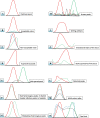Mastering DNA chromatogram analysis in Sanger sequencing for reliable clinical analysis
- PMID: 37955813
- PMCID: PMC10643650
- DOI: 10.1186/s43141-023-00587-6
Mastering DNA chromatogram analysis in Sanger sequencing for reliable clinical analysis
Abstract
Background: Sanger dideoxy sequencing is vital in clinical analysis due to its accuracy, ability to analyze genetic markers like SNPs and STRs, capability to generate reliable DNA profiles, and its role in resolving complex clinical cases. The precision and robustness of Sanger sequencing contribute significantly to the scientific basis of clinical investigations. Though the reading of chromatograms seems to be a routine step, many errors conducted in PCR may lead to consequent limitations in the readings of AGCT peaks. These errors are possibly associated with improper DNA amplification and its subsequent interpretation of DNA sequencing files, such as noisy peaks, artifacts, and confusion between double-peak technical errors, heterozygosity, and double infection potentials. Thus, it is not feasible to read nucleic acid sequences without giving serious attention to these technical problems. To ensure the accuracy of DNA sequencing outcomes, it is also imperative to detect and rectify technical challenges that may lead to misinterpretation of the DNA sequence, resulting in errors and incongruities in subsequent analyses.
Short conclusion: This overview sheds light on prominent technical concerns that can emerge prior to and during the interpretation of DNA chromatograms in Sanger sequencing, along with offering strategies to address them effectively. The significance of identifying and tackling these technical limitations during the chromatogram analysis is underscored in this review. Recognizing these concerns can aid in enhancing the quality of downstream analyses for Sanger sequencing results, which holds notable improvement in accuracy, reliability, and ability to provide crucial genetic information in clinical analysis.
Keywords: Chromatogram files; Electropherograms; Sanger sequencing; Technical issues; Tips; Troubleshoot.
© 2023. The Author(s).
Conflict of interest statement
The authors declare that they have no competing interests.
Figures
Similar articles
-
ClinQC: a tool for quality control and cleaning of Sanger and NGS data in clinical research.BMC Bioinformatics. 2016 Feb 2;17:56. doi: 10.1186/s12859-016-0915-y. BMC Bioinformatics. 2016. PMID: 26830926 Free PMC article.
-
Automated Sanger Analysis Pipeline (ASAP): A Tool for Rapidly Analyzing Sanger Sequencing Data with Minimum User Interference.J Biomol Tech. 2016 Dec;27(4):129-131. doi: 10.7171/jbt.16-2704-005. Epub 2016 Oct 17. J Biomol Tech. 2016. PMID: 27790076 Free PMC article.
-
ChromatoGate: A Tool for Detecting Base Mis-Calls in Multiple Sequence Alignments by Semi-Automatic Chromatogram Inspection.Comput Struct Biotechnol J. 2013 May 8;6:e201303001. doi: 10.5936/csbj.201303001. eCollection 2013. Comput Struct Biotechnol J. 2013. PMID: 24688709 Free PMC article.
-
Nanopore Sequencing in a Clinical Routine Laboratory: Challenges and Opportunities.Clin Lab. 2020 Jun 1;66(6). doi: 10.7754/Clin.Lab.2019.191114. Clin Lab. 2020. PMID: 32538066 Review.
-
Next-Generation Sequencing and Emerging Technologies.Semin Thromb Hemost. 2019 Oct;45(7):661-673. doi: 10.1055/s-0039-1688446. Epub 2019 May 16. Semin Thromb Hemost. 2019. PMID: 31096307 Review.
Cited by
-
Targeted Amplicon Genotyping by Sanger Sequencing.Methods Mol Biol. 2025;2943:167-175. doi: 10.1007/978-1-0716-4642-7_14. Methods Mol Biol. 2025. PMID: 40580294
-
In vitro evaluation of porcine reproductive and respiratory syndrome virus (PRRSV) ORF5 sequences in samples containing PRRSV modified-live vaccine and wild-type strains.J Vet Diagn Invest. 2025 Jul;37(4):716-721. doi: 10.1177/10406387251340342. Epub 2025 May 15. J Vet Diagn Invest. 2025. PMID: 40371811 Free PMC article.
-
Sanger Sequencing Reveals Novel Variants in GLO-1, ACE, and CBR1 Genes in Patients of Early and Severe Diabetic Nephropathy.Medicina (Kaunas). 2024 Sep 20;60(9):1540. doi: 10.3390/medicina60091540. Medicina (Kaunas). 2024. PMID: 39336582 Free PMC article.
-
Identification and Phylogenetic Analysis of Flavobacterium spp. Associated with Aquaculture Fish Diseased from Brazil.Pathogens. 2025 Feb 22;14(3):219. doi: 10.3390/pathogens14030219. Pathogens. 2025. PMID: 40137703 Free PMC article.
-
Rapid and supersensitive allele detection of Plasmodium falciparum chloroquine resistance via a Pyrococcus furiosus argonaute-triggered dual-signal biosensing platform.Parasit Vectors. 2024 Nov 24;17(1):488. doi: 10.1186/s13071-024-06575-0. Parasit Vectors. 2024. PMID: 39582041 Free PMC article.
References
-
- Men AE, Wilson P, Siemering K, Forrest S (2008) Sanger DNA sequencing. In: Next Gener Genome Seq Towards Personalized Medicine. John Wiley & Sons, Hoboken
-
- Walker SE, Lorsch J. Sanger dideoxy sequencing of DNA In: Methods in enzymology. Elsevier; 2013. pp. 171–184. - PubMed
-
- Aljubouri TRS, Al-Shuhaib MBS. Genotyping of mitochondrial D-loop sequences in three breeds of sheep. Biologia (Bratisl) 2020;76:203–211. doi: 10.2478/s11756-020-00543-6. - DOI
Publication types
LinkOut - more resources
Full Text Sources

